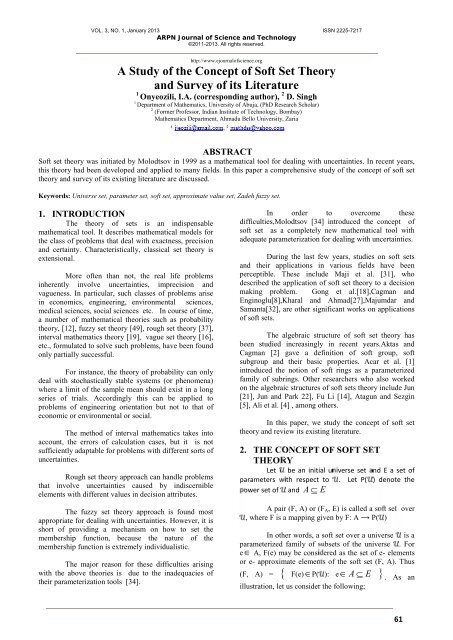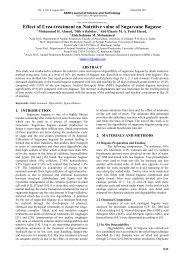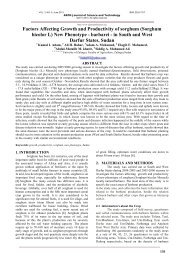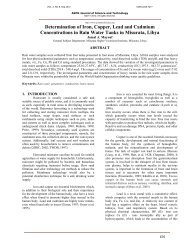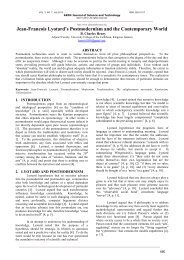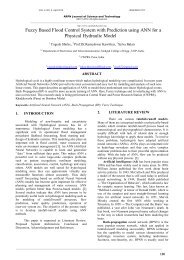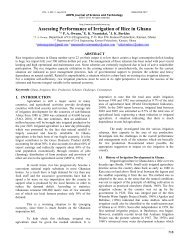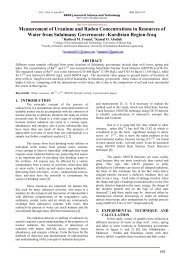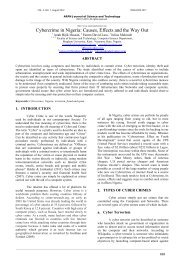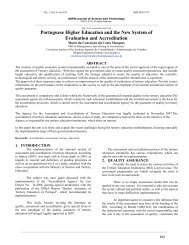A Study of the Concept of Soft Set TheoryAnd Survey Of Its Literature
A Study of the Concept of Soft Set TheoryAnd Survey Of Its Literature
A Study of the Concept of Soft Set TheoryAnd Survey Of Its Literature
Create successful ePaper yourself
Turn your PDF publications into a flip-book with our unique Google optimized e-Paper software.
VOL. 3, NO. 1, January 2013 ISSN 2225-7217ARPN Journal <strong>of</strong> Science and Technology©2011-2013. All rights reserved.by;Then, <strong>the</strong> α – level set <strong>of</strong> F best and F poor are givenF best (0.2) = {h 1 , h 2 , h 5 , h 6 } ; F poor (0.2) = { h 1 ,h 2 , h 3 h 4 , h 5 }F best (0.7) = {h 2 , h 5 , h 6 } ; F poor (0.3) = { h 1 ,h 3 h 4 }F best (0.9) = {h 5 , h 6 } ; F poor (0.9) = { h 1 ,h 3 h 4 }F best (1.0) = {h 6 } ; F poor (1.0) = {h 3h 4 }Where here A = {0.2, 0.7, 0.9, 1.0}⊂ [0, 1]which can be regarded as <strong>the</strong> parameter set such thatF best: A⟶ P( ) gives <strong>the</strong> approximate value set F best (∝),for ∝ ∈ A. Thus, <strong>the</strong> s<strong>of</strong>t set for <strong>the</strong> fuzzy set F best can bewritten as;(F best , A) = {(0.2, {h 1 , h 2 , h 5 , h 6 }), (0.7, {h 2 , h 5 ,h 6 }), (0.9, {h 5 , h 6 }), (1.0, {h 6 })}.Similarly <strong>the</strong> s<strong>of</strong>t set for <strong>the</strong> fuzzy set F poor , isgiven by;http://www.ejournal<strong>of</strong>science.org(a) The lower approximation <strong>of</strong> X, denoted by R ∗ Xand defined as;R ∗ X = {x ∈ : [x] R ⊆ X} which consist <strong>of</strong> <strong>the</strong>set <strong>of</strong> all objects that certainly belong to X.(b) The upper approximation <strong>of</strong> X denoted by R*Xdefined as;R*X = {x ∈ : [x] R ∩ X ≠ } consisting <strong>of</strong> <strong>the</strong>set <strong>of</strong> all objects which possibly belong toX. Then <strong>the</strong> set X is called a rough set if;R*X − R ∗X ≠ and X is crisp if R*X − R ∗X =.(v) A vague set V is a set characterized by twomembership functions viz, a true membership functiont v : ⟶ [0, 1] and a false membership function f v : ⟶[0, 1], with0≤t v (x)+f v (x) ≤ 1 and V is represented as;V = {(x, [t v (x), f v (x)]: x ∈ }, where <strong>the</strong> interval [t v (x),1−f v (x)] is called <strong>the</strong> vague value <strong>of</strong> x in V.(F poor , B) = { (0.2{ h 1 , h 2 , h 3 h 4 , h 5 }), (0.3{ h 1 , h 3h 4 }), (0.9{ h 1 , h 3 h 4 }), (1.0{h 3 h 4 })}:Where B = {0.2, 0.3, 0.9, 1.0}⊂ [0, 1].In order to have a comparative view <strong>of</strong> s<strong>of</strong>t setwith o<strong>the</strong>r existing sets, we briefly define <strong>the</strong> following:Let be an initial universe, E a set <strong>of</strong> parameters, P( )<strong>the</strong> power set <strong>of</strong> and A ⊆ E.(i) A classical (or crisp) set C ⊆ is a setcharacterized by <strong>the</strong> function χ C , called <strong>the</strong> characteristicfunction <strong>of</strong> C, where χ C : ⟶ {0, 1} and C is defined byC = {x∈ : χ(x) =1,if x C0,if x C(ii) A multi set M ⊆ is a set characterized by anumeric– valued function α M : ⟶{IN ∪ 0} where M isdefined byM = {x ∈ : α M (x) =}IN,if x M0,if x M(iii) A fuzzy set F over is a set characterized by amembership function μ F <strong>of</strong> Fwhere μ F : ⟶ [0, 1] and F is represented by;F = {(x, μ F (x)): x ∈ , μ F (x) ∈ [0, 1]}.(iv) Let R be an equivalence relation on , and for x∈ , let [x] R denote <strong>the</strong> equivalence class <strong>of</strong> Rdetermined by x. Let X ⊆ , X is characterized withrespect to R by a pair <strong>of</strong> crisp sets called;}.(vi) A s<strong>of</strong>t set (F, A), F A or (f A , E) over ischaracterized by an approximate set valued function; f A :E⟶ P ( ) and (F, A) is represented as a set <strong>of</strong> orderedpairs defined as;(F, A) = {(x, f A (x): f A (x) ∈ P( ) and f A (x) = ,if x ∉ A}.3. LITERATURE REVIEW OF SOFT SETTHEORYMolodtsov [34] initiated <strong>the</strong> concept <strong>of</strong> s<strong>of</strong>t set<strong>the</strong>ory as a general ma<strong>the</strong>matical tool for solvingcomplicated problems dealing with vagueness anduncertainties which classical methods and some modernma<strong>the</strong>matical methods, such as probability <strong>the</strong>ory [12],fuzzy set <strong>the</strong>ory [49], rough set <strong>the</strong>ory [37], intervalma<strong>the</strong>matics <strong>the</strong>ory[19], vague set <strong>the</strong>ory [16] etc.,cannot successfully solve due to inadequacy <strong>of</strong> <strong>the</strong>irparameterization tools.Molodtsov [34] pointed out that s<strong>of</strong>t set <strong>the</strong>oryprovides enough parameter and as a resultaccommodates initial approximate descriptions <strong>of</strong> anobject. This, he said, makes s<strong>of</strong>t set <strong>the</strong>ory free from <strong>the</strong>above difficulty and becomes very convenient and easilyapplicable in practice. Molodtsov[34] <strong>the</strong>refore defines as<strong>of</strong>t set as a parameterized family <strong>of</strong> subsets <strong>of</strong> auniverse set, where each element is considered as <strong>the</strong> set<strong>of</strong> approximate elements <strong>of</strong> <strong>the</strong> s<strong>of</strong>t set. He alsosuccessfully applied s<strong>of</strong>t set <strong>the</strong>ory in areas such assmoothness <strong>of</strong> function (where he compared smoothness<strong>of</strong> function as being similar to continuity <strong>of</strong> functions in<strong>the</strong> classical case), game <strong>the</strong>ory, operation research,Riemann and Perron integrations, probability <strong>the</strong>ory andmeasurement <strong>the</strong>ory, and introduced <strong>the</strong> basic notions <strong>of</strong><strong>the</strong> <strong>the</strong>ory <strong>of</strong> s<strong>of</strong>t sets.63
VOL. 3, NO. 1, January 2013 ISSN 2225-7217ARPN Journal <strong>of</strong> Science and Technology©2011-2013. All rights reserved.Based on <strong>the</strong> work <strong>of</strong> Molodtsov [34],Maji etal.,[30] initiated <strong>the</strong> <strong>the</strong>oretical study <strong>of</strong> <strong>the</strong> s<strong>of</strong>t set<strong>the</strong>ory. This includes, <strong>the</strong> definition <strong>of</strong> s<strong>of</strong>t subset, s<strong>of</strong>tsuperset, equality <strong>of</strong> s<strong>of</strong>t sets, and complement <strong>of</strong> a s<strong>of</strong>tset among o<strong>the</strong>rs, with some illustrative examples. S<strong>of</strong>tbinary operations such as AND OR operations, unionand intersection operations are also defined. Theyverified De Morgan’s law and presented a number <strong>of</strong>results on s<strong>of</strong>t set <strong>the</strong>ory. For <strong>the</strong> purpose <strong>of</strong> storing as<strong>of</strong>t set in a computer, <strong>the</strong>y represented a s<strong>of</strong>t set in <strong>the</strong>form <strong>of</strong> a table.Yang [48] was <strong>the</strong> first to point out error in <strong>the</strong>work <strong>of</strong> Maji et al., [30] by giving a counter example.Ali et al.,[3] also pointed out several assertions in Maji etal. ,[30]that are not true in general by counter examplesSome new operations such as restricted union, restrictedintersection, restricted difference and extendedintersection were fur<strong>the</strong>r introduced. Moreover <strong>the</strong>yimproved on <strong>the</strong> notion <strong>of</strong> complement <strong>of</strong> a s<strong>of</strong>t set andproved that certain De Morgan’s laws hold in s<strong>of</strong>t set<strong>the</strong>ory with respect to <strong>the</strong>se new operations. They alsoremarked that <strong>the</strong> incorrectness <strong>of</strong> <strong>the</strong> assertionsmentioned above may be as a result <strong>of</strong> <strong>the</strong> way andmanner some <strong>of</strong> <strong>the</strong> related notions were defined.http://www.ejournal<strong>of</strong>science.orgapplication <strong>of</strong> injective s<strong>of</strong>t set in decision makingproblem.Xiao et al. [46], reviewed <strong>the</strong> notions <strong>of</strong> s<strong>of</strong>tsets and injective s<strong>of</strong>t sets and proposed <strong>the</strong> notion <strong>of</strong>exclusive disjunctive s<strong>of</strong>t sets. Some studies onoperations <strong>of</strong> exclusive disjunctive s<strong>of</strong>t sets such asrestricted/ relaxed AND- operations and <strong>the</strong> dependencybetween exclusive disjunctive s<strong>of</strong>t sets and injective s<strong>of</strong>tsets were also established. They finally gave anapplication <strong>of</strong> exclusive disjunctive s<strong>of</strong>t set to attributereduction <strong>of</strong> incomplete information system and pointedout that potential studies could be focusing on how toextend it to fuzzy s<strong>of</strong>t set as well as applying it insolving decision- making problems.Babitha and Sunil [6] introduced <strong>the</strong> concept <strong>of</strong>s<strong>of</strong>t set relation as a sub s<strong>of</strong>t set <strong>of</strong> <strong>the</strong> Cartesian product<strong>of</strong> s<strong>of</strong>t sets. Besides, many related concepts such asequivalence s<strong>of</strong>t set relation, partition <strong>of</strong> s<strong>of</strong>t set, s<strong>of</strong>t setfunction, composition <strong>of</strong> s<strong>of</strong>t set functions with relatedresults were proposed. In <strong>the</strong>ir concluding remarks, <strong>the</strong>yproposed a future research on <strong>the</strong> <strong>the</strong>oretical aspect <strong>of</strong><strong>the</strong>se generalized concepts in relation to topologygenerated by s<strong>of</strong>t set relation.Ge and Yang [17], fur<strong>the</strong>r investigated <strong>the</strong>operational rules given by Maji et al. [30] and Ali et al.,[3] and obtained some necessary and sufficientconditions for <strong>the</strong> rules to hold. They specifically notedthat several assertions in relation to null s<strong>of</strong>t set andabsolute s<strong>of</strong>t set are incorrect, due to <strong>the</strong> notation <strong>of</strong> <strong>the</strong>related definitions in Maji et al. ,[30].Fu Li [15] also pointed out some errors in [30]and corrected <strong>the</strong>m. He also discussed <strong>the</strong> distributivelaws with respect to certain operations <strong>of</strong> union andintersection introduced in [3], using De Morgan laws.Sezgin and Atagun [40], proved that certain DeMorgan’s laws with respect to different operations ons<strong>of</strong>t set defined by (Maji et al. ,[30], (Pei and Miao [38]and Ali et al. ,[3] hold. They fur<strong>the</strong>r discussed variousbasic properties <strong>of</strong> operations on s<strong>of</strong>t set such as union,restricted union, extended and restricted intersections,restricted difference and <strong>the</strong>ir interconnection between<strong>the</strong>m. Finally <strong>the</strong>y defined <strong>the</strong> notion <strong>of</strong> restrictedsymmetric difference <strong>of</strong> s<strong>of</strong>t sets and investigated itsproperties with examples.Singh and Onyeozili [42, 43, 44] establishedand investigated (with illustrative examples) someresults on distributive and absorption properties withrespect to various operations on s<strong>of</strong>t sets.Gong et al. [18], proposed <strong>the</strong> concept <strong>of</strong>injective s<strong>of</strong>t set and some <strong>of</strong> its operations such as <strong>the</strong>restricted AND <strong>the</strong> relaxed AND operations. They alsodefined <strong>the</strong> dependency between two injective s<strong>of</strong>t setsand <strong>the</strong> injective s<strong>of</strong>t decision system and gave anIn continuation <strong>of</strong> <strong>the</strong>ir work, Babitha et al. ,[7],introduced <strong>the</strong> concept <strong>of</strong> anti- symmetric relation andtransitive closure <strong>of</strong> a s<strong>of</strong>t set relation and proposed ananalogue <strong>of</strong> Warshall’s algorithm for calculating <strong>the</strong>transitive closure <strong>of</strong> a s<strong>of</strong>t set relation. They also definedordering on a s<strong>of</strong>t set and established <strong>the</strong> relationshipbetween different orderings supported with examples.In an attempt to broaden <strong>the</strong> <strong>the</strong>oretical aspect<strong>of</strong> s<strong>of</strong>t set relation, Yang et al. [47], introduced <strong>the</strong>notions <strong>of</strong> anti- reflexive kernel, symmetric kernel,reflexive closure and symmetric closure <strong>of</strong> a s<strong>of</strong>t setrelation and obtained with pro<strong>of</strong>s some results involving<strong>the</strong>m. The notions <strong>of</strong> s<strong>of</strong>t set relation mapping and itsinverse were also proposed and some <strong>of</strong> <strong>the</strong>ir relatedproperties discussed.Qin and Hong [39] made a <strong>the</strong>oretical study <strong>of</strong><strong>the</strong> algebraic structures <strong>of</strong> s<strong>of</strong>t sets such as latticestructures and introduced <strong>the</strong> concept <strong>of</strong> s<strong>of</strong>t equalityrelation and also discussed its related properties. It wasproved that s<strong>of</strong>t equality relation is a congruence relationwith respect to some operations. They finally established<strong>the</strong> quotient algebra with respect to restricted union (⋃ R )and extended intersection (⋂ E ).Won Keon Min [33] introduced and studied <strong>the</strong>concept <strong>of</strong> similarity between s<strong>of</strong>t sets which is anextension <strong>of</strong> <strong>the</strong> equality for s<strong>of</strong>t sets and investigatedsome properties. He also introduced <strong>the</strong> concept <strong>of</strong>conjunctive ( ∝∧β) and disjunctive ( ∝ ∨ β) <strong>of</strong> orderedpair parameter ( ∝, β) for s<strong>of</strong>t set <strong>the</strong>ory; modified andinvestigated some operations <strong>of</strong> s<strong>of</strong>t set <strong>the</strong>oryintroduced by ( Maji et al. ,2003).64
VOL. 3, NO. 1, January 2013 ISSN 2225-7217ARPN Journal <strong>of</strong> Science and Technology©2011-2013. All rights reserved.Kharal and Ahmad [27] introduced <strong>the</strong> notion <strong>of</strong>mapping on s<strong>of</strong>t classes and study several properties <strong>of</strong>images and inverse images <strong>of</strong> s<strong>of</strong>t sets supported wi<strong>the</strong>xamples and counter examples. An application <strong>of</strong> <strong>the</strong>senotions to <strong>the</strong> problem <strong>of</strong> medical diagnosis in medicalexpect systems where a patient’s complaints orsymptoms may easily be encoded into a s<strong>of</strong>t set, wasfinally given.In line with <strong>the</strong> work <strong>of</strong> Kharal and Ahmad[27], Majumdar and Samanta [32] introduced <strong>the</strong> idea <strong>of</strong>s<strong>of</strong>t mapping and studied some <strong>of</strong> its properties with <strong>the</strong>observation that fuzzy mapping is a special case <strong>of</strong> s<strong>of</strong>tmapping. Majumdar et al. [32] also defined <strong>the</strong> imageand <strong>the</strong> respective inverse image <strong>of</strong> a s<strong>of</strong>t set under a s<strong>of</strong>tmapping and studied some <strong>of</strong> <strong>the</strong>ir properties. They alsoapplied <strong>the</strong> s<strong>of</strong>t mapping in medical diagnosis problemand remarked that <strong>the</strong> model used in <strong>the</strong> diagnosis wasvery preliminary and may be improved by incorporatingdetailed disease- symptom information and clinicalresults. For future research, a work on <strong>the</strong> <strong>the</strong>ory <strong>of</strong>fuzzy s<strong>of</strong>t mapping and <strong>the</strong> intuitionist fuzzy s<strong>of</strong>tmapping was also proposed.Chen et al..[11] pointed out that <strong>the</strong> result <strong>of</strong>s<strong>of</strong>t set reductions proposed by( Maji et al. ,[31] wasincorrect and explained with example that <strong>the</strong> algorithmsused to first compute <strong>the</strong> redact -s<strong>of</strong>t set and <strong>the</strong>n <strong>the</strong>choice value for selecting <strong>the</strong> optimal objects in <strong>the</strong>decision problem were unreasonable. As a result, <strong>the</strong>yproposed a new definition <strong>of</strong> parameter reduction for <strong>the</strong>improvement <strong>of</strong> Maji et al. ,[31] and concluded that <strong>the</strong>idea <strong>of</strong> redact under rough set <strong>the</strong>ory generally cannot beapplied directly in redact under s<strong>of</strong>t set <strong>the</strong>ory, with <strong>the</strong>observation that <strong>the</strong> parameter reduction may well playan important role in some knowledge discoveryproblems.Kong et al.,[28] analyzed that <strong>the</strong> problems <strong>of</strong>sub- optimal choice was not addressed by Chen et al.,[11] and so introduced <strong>the</strong> definition <strong>of</strong> normalparameter reduction in s<strong>of</strong>t set <strong>the</strong>ory to overcome <strong>the</strong>problems in Chen’s model. Two new definitions viz,-<strong>the</strong>parameter important degree and <strong>the</strong> s<strong>of</strong>t decisionpartition were described and use to analyze <strong>the</strong>algorithm <strong>of</strong> normal parameter reduction. They notedthat with this approach, <strong>the</strong> optimal choices are stillpreserved.http://www.ejournal<strong>of</strong>science.orgbased on <strong>the</strong> notion <strong>of</strong> multi-s<strong>of</strong>t sets, constructed from amulti-valued information system and obtained a resultwhich turned out to be equivalent to Pawlak’s rough setreduction.Pei and Miao[38] and Xiao et al.[46] discussed<strong>the</strong> relationship between s<strong>of</strong>t sets and informationsystems and showed that s<strong>of</strong>t sets are a class <strong>of</strong> specialinformation systems.Various applications <strong>of</strong> s<strong>of</strong>t set <strong>the</strong>ory weremade by several authors. Maji et al. ,[31], gave apractical application <strong>of</strong> s<strong>of</strong>t sets in decision makingproblem using <strong>the</strong> notion <strong>of</strong> knowledge reduction inrough set <strong>the</strong>ory <strong>of</strong> Pawlak [37].Later, Cagman and Enginolu [8] redefined someoperations <strong>of</strong> s<strong>of</strong>t set <strong>the</strong>ory in order to make <strong>the</strong>m morefunctional for improving several new results. Fourproducts <strong>of</strong> s<strong>of</strong>t sets viz-AND ( ∧) - product, OR ( ∨)-product AND-Not ( ⊼)- product and OR-NOT ( ⊻)-product were also defined and <strong>the</strong>ir properties discussed.Using AND ( ∧)-product, <strong>the</strong>y constructed an uni-int(union- intersection) s<strong>of</strong>t decision making method whichselect a set <strong>of</strong> optimum elements from <strong>the</strong> alternativeswithout using <strong>the</strong> rough sets and fuzzy s<strong>of</strong>t sets. Theyfinally applied <strong>the</strong> method to a decision making problem,remarking that apart from <strong>the</strong> uni-int s<strong>of</strong>t decisionmethod, similar types <strong>of</strong> decision methods using int-uni(intersection-union), uni-uni (union -union) and int-int(intersection-intersection can be constructed for ∨-product, ⊼-product and ⊻-product respectively in asimilar way though with some modifications.Similar to <strong>the</strong>ir work in Cagman andEnginoglu,[9], <strong>the</strong>y introduced s<strong>of</strong>t matrices which arerepresentation <strong>of</strong> s<strong>of</strong>t sets and defined AND (∧), OR (∨),AND-NOT (⊼) and OR-NOT ( ⊻) products <strong>of</strong> s<strong>of</strong>tmatrices. Also using <strong>the</strong> AND-product <strong>of</strong> s<strong>of</strong>t matrices,<strong>the</strong>y constructed a s<strong>of</strong>t max-min (maximum -minimum)decision making method and applied it to a real estateproblem, noting that similarly, o<strong>the</strong>r products ∨, ⊼ and ⊻<strong>of</strong> s<strong>of</strong>t matrices could be used for o<strong>the</strong>r convenient orsimilar problems.O<strong>the</strong>r works on applications <strong>of</strong> s<strong>of</strong>t set <strong>the</strong>oryinclude( Chen et al. ,[11]), (Gong et al. ,[18]), (Kharal etal. ,[27]), (Majundar et al. ,[32]), among o<strong>the</strong>rs.Zou and Xiao[50], proposed a new techniquefor decision making <strong>of</strong> s<strong>of</strong>t set <strong>the</strong>ory under incompleteinformation systems which is based on <strong>the</strong> calculation <strong>of</strong>weighted –average <strong>of</strong> all possible choice values <strong>of</strong>object.Herewan et al.[20] also analyzed <strong>the</strong> existingworks on attributes and parameterization reduction <strong>of</strong>s<strong>of</strong>t sets proposed by Maji et al. ,[31], Zou et al. ,[50]and remarked that all <strong>the</strong> techniques were based onBoolean- valued information system. They proposed analternative approach for attribute reduction which wasThe algebraic structures <strong>of</strong> s<strong>of</strong>t set <strong>the</strong>ory havealso been studied extensively. Aktas and Cagman [2],introduced <strong>the</strong> basic concepts <strong>of</strong> s<strong>of</strong>t groups, s<strong>of</strong>tsubgroups, normal s<strong>of</strong>t subgroups and s<strong>of</strong>thomomorphism and discussed <strong>the</strong>ir basic properties.Feng et al. [13] considered <strong>the</strong> algebraicstructure <strong>of</strong> smearing and introduced <strong>the</strong> notion <strong>of</strong> s<strong>of</strong>tsmearing. They studied and investigated some basicalgebraic properties <strong>of</strong> s<strong>of</strong>t smearing and some relatednotions such as s<strong>of</strong>t ideals, idealistic s<strong>of</strong>t semirings ands<strong>of</strong>t smearing homomorphism with illustrative examples65
VOL. 3, NO. 1, January 2013 ISSN 2225-7217ARPN Journal <strong>of</strong> Science and Technology©2011-2013. All rights reserved.Based on <strong>the</strong> work <strong>of</strong> Feng et al. [13]), Acar etal. [1] introduced <strong>the</strong> basic notions <strong>of</strong> s<strong>of</strong>t rings as aparameterized family <strong>of</strong> subrings <strong>of</strong> a ring over a ringwith some illustrative examples. They also introduced<strong>the</strong> notions <strong>of</strong> s<strong>of</strong>t subrings, s<strong>of</strong>t ideal <strong>of</strong> a s<strong>of</strong>t ring,idealistic s<strong>of</strong>t rings and s<strong>of</strong>t ring homomorphism withsome corresponding examples.In relation to <strong>the</strong> work <strong>of</strong> Acar et al. [1], Celiket al.,[10] introduced some new operations on s<strong>of</strong>t ringsuch as extended sum, restricted sum, extended product,restricted product and established some <strong>of</strong> <strong>the</strong>ir basicproperties.Ali et al.,[4]defined some algebraic structuressuch as semi groups, semirings and lattices associatedwith s<strong>of</strong>t sets, and completely described <strong>the</strong> distributiveand absorption laws on operations <strong>of</strong> s<strong>of</strong>t. MV- algebrasand BCK-algebras associated with s<strong>of</strong>t set, with a fixedset <strong>of</strong> parameters were also studied.Atagun and Sezgin[5], introduced and studiedsome sub structures such as s<strong>of</strong>t subrings and s<strong>of</strong>t ideals<strong>of</strong> a ring, s<strong>of</strong>t subfield <strong>of</strong> a field and s<strong>of</strong>t sub module <strong>of</strong> amodule with several illustrative examples. Some relatedproperties on operations <strong>of</strong> restricted intersection,product and sum for <strong>the</strong>se s<strong>of</strong>t sub- structures wereestablished and investigated with examples.In ano<strong>the</strong>r work <strong>of</strong> Sezgin and Atagun [40],<strong>the</strong>y first corrected some assertions in (S<strong>of</strong>t set and s<strong>of</strong>tgroup by (Aktas and Cagman, [2]) and fur<strong>the</strong>r extended<strong>the</strong> <strong>the</strong>oretical aspects <strong>of</strong> s<strong>of</strong>t group defined in (Aktasand Cagman,[2]) by introducing <strong>the</strong> concept <strong>of</strong>normalistic s<strong>of</strong>t group, normalistic s<strong>of</strong>t grouphomomorphism, and establishing that <strong>the</strong> normalistics<strong>of</strong>t group isomorphism is an equivalence relation onnormalistic s<strong>of</strong>t groups.Fu Li [14] defined <strong>the</strong> notion <strong>of</strong> s<strong>of</strong>t lattice, and<strong>the</strong> operations on s<strong>of</strong>t lattice with several examples.(Nagaranjan and Meenambigar,2011)fur<strong>the</strong>r defined s<strong>of</strong>tlattices, s<strong>of</strong>t distributive lattices, s<strong>of</strong>t modular lattices,s<strong>of</strong>t lattice ideals and s<strong>of</strong>t lattice homomorphism andinvestigated several related properties and somecharacterization <strong>the</strong>orems, while Karaaslan et al. ,[26]also defined s<strong>of</strong>t lattices and <strong>the</strong>ir substructures differentfrom <strong>the</strong> above authors (Fu Li ,[14] and Nagaranjan et al.,[35]).Jun[21] applied <strong>the</strong> notion <strong>of</strong> s<strong>of</strong>t sets to <strong>the</strong><strong>the</strong>ory <strong>of</strong> BCK/BCI- algebras and introduced <strong>the</strong> notion<strong>of</strong> s<strong>of</strong>t BCK/ BCI- algebras and s<strong>of</strong>t sub algebras and<strong>the</strong>n derived <strong>the</strong>ir basic properties with some illustrativeexamples.Lee et al.[29] and Jun et al.[23] introduced <strong>the</strong>notions <strong>of</strong> implicative, positive implicative andcommutative s<strong>of</strong>t ideals. They also introduced <strong>the</strong> notion<strong>of</strong> idealistic s<strong>of</strong>t BCK- algebra with some illustrativeexamples and derived <strong>the</strong>ir basic properties.http://www.ejournal<strong>of</strong>science.orgJun et al.[24] introduced <strong>the</strong> concept <strong>of</strong> s<strong>of</strong>tHilbert algebra, s<strong>of</strong>t Hilbert abysmal algebra and s<strong>of</strong>tHilbert deductive algebra and investigated <strong>the</strong>irproperties. Jun et al. ,[24] also in ano<strong>the</strong>r paper,introduced <strong>the</strong> notion <strong>of</strong> s<strong>of</strong>t p- ideals and p- idealistics<strong>of</strong>t BCI- algebras and discussed <strong>the</strong>ir basic properties.Some o<strong>the</strong>r authors who have studied on <strong>the</strong> algebraicstructures <strong>of</strong> s<strong>of</strong>t set <strong>the</strong>ory include (Jun and Park [22]),(Sun et al.[45]), (Qin and Hong,[39]), (Ozturk et al.,[36], among o<strong>the</strong>rs.4. CONCLUSION AND FUTURE WORKS<strong>of</strong>t set <strong>the</strong>ory, introduced by Molodtsov in1999 is an effective tool with adequate parameterizationin dealing with problems <strong>of</strong> uncertainties. Recently,various researches had been done on this <strong>the</strong>ory both in<strong>the</strong>ory and in practice. In this paper, a study <strong>of</strong> <strong>the</strong>concept <strong>of</strong> s<strong>of</strong>t set <strong>the</strong>ory and review <strong>of</strong> its existingliterature is carried out. To extend this work, one couldgeneralize it to fuzzy s<strong>of</strong>t set <strong>the</strong>ory, multi set <strong>the</strong>ory ands<strong>of</strong>t multi set <strong>the</strong>ory.REFERENCES[1] Acar, U., Koyuncu, F. and Tanay, B. (2010). S<strong>of</strong>tsets and s<strong>of</strong>t rings, Computers and Ma<strong>the</strong>maticswith Applications, 59, 3458- 3463.[2] Atkas, H. and Cagman, N. (2007). S<strong>of</strong>t sets ands<strong>of</strong>t groups, Information sciences, 1, 2726-2735.[3] Ali, M. I., Feng, F., Lui, X., Min, W. K. andshabir, M. (2009). On some new operations in s<strong>of</strong>tset <strong>the</strong>ory, Computers and Ma<strong>the</strong>matics withApplications, 57, 1547- 1553.[4] Ali, M. I., Shabir, M. and Naz, M. (2011).Algebraic structures <strong>of</strong> s<strong>of</strong>t sets associated withnew operation, Computers and Ma<strong>the</strong>matics withApplications, 61, 2647- 2654.[5] Atagun, A. O. and Sezgin, A. (2011). S<strong>of</strong>tsubstructures <strong>of</strong> rings, fields and modules,Computers and Ma<strong>the</strong>matics with Applications,61, 592- 601.[6] Babitha, K. V. and Sunil, J. J. (2010). S<strong>of</strong>t setrelation and functions, Computers andMa<strong>the</strong>matics with Applications, 60, 1840- 1849.[7] Babitha, K.V. and Sunil, J. J. (2011). Transitiveclosure and ordering on s<strong>of</strong>t sets, Computers andMa<strong>the</strong>matics with Applications, 61, 2235- 2239.[8] Cagman, N. and Enginoglu, S. (2010).S<strong>of</strong>t set<strong>the</strong>ory and uni- int decision making, EuropeanJournal <strong>of</strong> operational research, 207, 848- 855.[9] Cagman N. and Enginoglu, S. (2010). S<strong>of</strong>t matrix<strong>the</strong>ory and its decision making, Computers andMa<strong>the</strong>matics with Applications, 59, 3308- 3314.66
VOL. 3, NO. 1, January 2013 ISSN 2225-7217ARPN Journal <strong>of</strong> Science and Technology©2011-2013. All rights reserved.http://www.ejournal<strong>of</strong>science.org[10] Celik, Y., Ekiz, C. and Yamak, S. (2011). A newview on s<strong>of</strong>t rings, Hacettepe Journal <strong>of</strong>ma<strong>the</strong>matics and statistics, 40, 273- 286.[11] Chen, D., Tsang, E.C.C., Yeung, D. S. and Wang,X. (2005). The parameterized reduction <strong>of</strong> s<strong>of</strong>tsets and its applications Computers andMa<strong>the</strong>matics with Applications, 49, 757- 763.[12] Dempster, A. P.(1958). A Generalization <strong>of</strong>Bayesian Inference, Journal <strong>of</strong> .Royal StatisticalSociety,30(Series B),205-247[13] Feng, F., Jun, Y. B. and Zhao, X. (2008). S<strong>of</strong>tsemirings, Computers and Ma<strong>the</strong>matics withApplications, 56, 2621- 2628.[14] Fu Li, (2010). S<strong>of</strong>t lattices, Global Journal <strong>of</strong>science Frontier Research, 10, 57- 59.[15] Fu Li, (2011). Notes on <strong>the</strong> s<strong>of</strong>t operations,A.R.P.N. Journal <strong>of</strong> system and s<strong>of</strong>twares, 1, 205-208.[16] Gau, W. L. and Buehrer, D. J. (1993). Vague sets, IEEE Trans. System Man Cybernet, 23, 610-614.[17] Ge, X. and Yang, S. (2011). Investigations onsome operations <strong>of</strong> s<strong>of</strong>t sets, World Academy <strong>of</strong>science Engineering and Technology, 75, 1113-1116.[18] Gong, K., Xiao, Z. and Zhang, X. (2010). Theinjective s<strong>of</strong>t set with its operations, Computersand Ma<strong>the</strong>matics with Applications, 60, 2270-2278.[19] Gorzalzany, M. B. (1987). A method <strong>of</strong> inferencein approximate reasoning based on intervalvaluedfuzzy sets, Fuzzy sets and systems, 21, 1-17.[20] Herawan , T., Ghazali, R. and Deris, M.(2010).S<strong>of</strong>t set Theoretic Approach for DimensionalityReduction, International Journal <strong>of</strong> Data baseTheory and Application, 3,47-60.[21] Jun, Y.B. (2008). S<strong>of</strong>t BCK/BCI -algebras,Computers and Ma<strong>the</strong>matics with Applications,56,1408-1413.[22] Jun, Y.B. and Park, C.H. (2008). Applications <strong>of</strong>s<strong>of</strong>t sets in ideals <strong>the</strong>ory <strong>of</strong> BCK/BCI- algebras,Information sciences, 178, 2466-2475.[23] Jun, Y.B and, Kim, H.S. and Park, C.H. (2011).Positive implicative ideals <strong>of</strong> BCK- algebrasbased on a s<strong>of</strong>t set <strong>the</strong>ory, Bulletin <strong>of</strong> <strong>the</strong>Malaysian math. Sci., soc., 34(2), 345-354.[24] Jun, Y.B. and Park, C.H. (2009). Application <strong>of</strong>s<strong>of</strong>t sets in Hilbert algebras, Iranian Journal <strong>of</strong>fuzzy systems 6(2), 75-86.[25] Jun, Y.B., Lee, K.J. and Zhan, J. (2009). S<strong>of</strong>t p -ideals <strong>of</strong> s<strong>of</strong>t BCI- algebras, Computers andMa<strong>the</strong>matics with Applications, 58(10), 2060-2068.[26] Karaaslan, F. , Cagman, N. and Enginoglu,s.(2012). S<strong>of</strong>t Lattices, Journal <strong>of</strong> New Results insciences, 1, 5-17.[27] Kharal, A. and Ahmad, B. (2011). Mappings onS<strong>of</strong>t Classes, New Ma<strong>the</strong>matics and NaturalComputation, 07, (3), 471.[28] Kong, Z. , Geo, L., Wang, L.,S. (2008). Thenormal parameter reduction <strong>of</strong> s<strong>of</strong>t sets and itsalgorithm, Computers and Ma<strong>the</strong>matics withApplications, 56, 3029-3037.[29] Lee, K. J., Jun, Y.B. and Park, C.H. (2011).Implicative s<strong>of</strong>t ideals and implicative idealistics<strong>of</strong>t BCK- algebras, Communication Koreanmath. Soc., 26(2), 183-196.[30] Maji, P.K., Biswas, R. and Roy, A.R. (2003). S<strong>of</strong>tset <strong>the</strong>ory, Computers and Ma<strong>the</strong>matics withApplications, 45, 555-562.[31] Maji, P.K., Biswas, R. and Roy, A.R. (2002). Anapplication <strong>of</strong> s<strong>of</strong>t sets in a decisions makingproblems, Computers and Ma<strong>the</strong>matics withApplications, 44, 1077-1083.[32] Majumdar, P. and Samanta, S.K. (2010). On s<strong>of</strong>tmappings, Computers and Ma<strong>the</strong>matics withApplications, 60,2666-2674.[33] Min, W.K. (2012). Similarity in s<strong>of</strong>t set <strong>the</strong>ory,Applied ma<strong>the</strong>matics letters, 25, 310-314.[34] Molodtsov, D.(1999). S<strong>of</strong>t set Theory-Firstresults, Computers and Ma<strong>the</strong>matics withApplications, 37, 19-31.[35] Nagarajan,E.R.R and Meenambigar, G. (2011).An application <strong>of</strong> s<strong>of</strong>t sets to Lattices, KragujevacJournal <strong>of</strong> ma<strong>the</strong>matics 35 (1), 95-87.[36] Ozturk, M.A. and Inna, E. (2011). S<strong>of</strong>t –rings andidealistic s<strong>of</strong>t –rings, Annuals <strong>of</strong> fuzzy maths. andinformation, 1(1), 71-80.[37] Pawlak, Z. (1982). Rough sets, InternationalJournal <strong>of</strong> information and computer sciences, 11,341-356.67
VOL. 3, NO. 1, January 2013 ISSN 2225-7217ARPN Journal <strong>of</strong> Science and Technology©2011-2013. All rights reserved.[38] Pei, D.and Miao, D.(2005). From s<strong>of</strong>t set toinformation systems, In: Proceedings <strong>of</strong> Granularcomputing IEEE, 2, 617-621.[39] Qin, K. and Hong Z. (2010). On s<strong>of</strong>t equality,Journal <strong>of</strong> Computational and AppliedMa<strong>the</strong>matics, 234, 1347-1355.http://www.ejournal<strong>of</strong>science.orgJournal <strong>of</strong> Computer Applications (0975 - 8887),59(4), 39- 44.[45] Sun, Q.M., Zhang, Z. and Liu, J. (2008). S<strong>of</strong>t setsand s<strong>of</strong>t modules, Proceedings <strong>of</strong> Rough sets andknowledge Technology, Third internationalconference RSKT, Chengdu, china, 403-409.[40] Sezgin, A. and Atagun, A.O. (2011). Onoperations <strong>of</strong> s<strong>of</strong>t sets, Computers andMa<strong>the</strong>matics with Applications, 60, 1840-1849.[41] Sezgin, A. and Atagun, A.O. (2011). S<strong>of</strong>t groupsand normalistic s<strong>of</strong>t group, Computers andMa<strong>the</strong>matics with Applications, 62, 685-698.[42] Singh, D. and Onyeozili, I. A. (2012). Someconceptual misunderstandings <strong>of</strong> <strong>the</strong> fundamentals<strong>of</strong> s<strong>of</strong>t set <strong>the</strong>ory, ARPN Journal <strong>of</strong> systems ands<strong>of</strong>tware, 2(9), 251- 254.[43] Singh, D. and Onyeozili, I. A. (2012). Someresults on distributive and absorption propertieson s<strong>of</strong>t operations, IOSR Journal <strong>of</strong> Ma<strong>the</strong>matics(IOSR-JM), 4(2), 18- 30.[44] Singh, D. and Onyeozili, I. A. (2012). On somenew properties <strong>of</strong> s<strong>of</strong>t set operations, International[46] Xiao, Z., Gong, K., Xia, S. and Zou, Y.(2010).Exclusive disjunctive s<strong>of</strong>t sets, Computers andMa<strong>the</strong>matics with Applications, 59, 2128-2137.[47] Yang, H. and, Guo, Z. (2011). Kenels andclosures <strong>of</strong> s<strong>of</strong>t set relations and s<strong>of</strong>t set relationmappings, Computers and Ma<strong>the</strong>matics withApplications 61, 651-662.[48] Yang, C. (2008). A note on ‘’S<strong>of</strong>t set Theory’’Computers and Ma<strong>the</strong>matics with Applications,56, 1899-1900.[49] Zadeh, L.A.(1965). Fuzzy sets, Information andcontrol, 8, 338-353.[50] Zou, Y. and Xiao, Z. (2008). Data analysisapproaches <strong>of</strong> s<strong>of</strong>t set under incompleteinformation, Knowledge-Based systems, 21, 941-945.68


